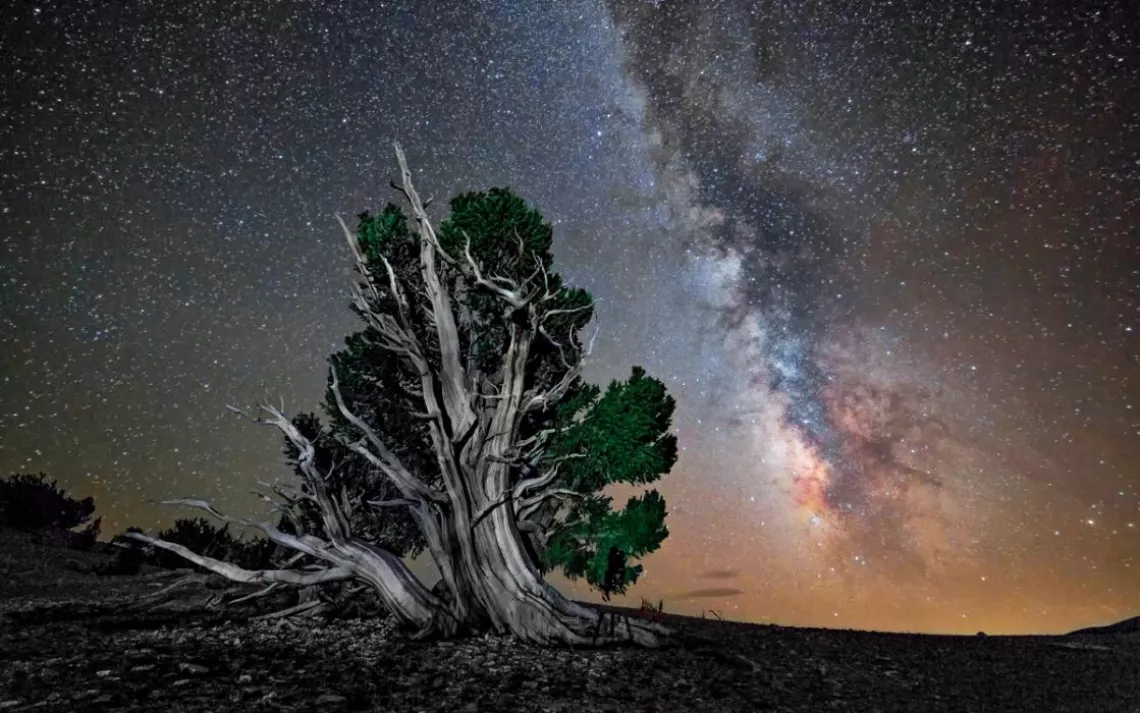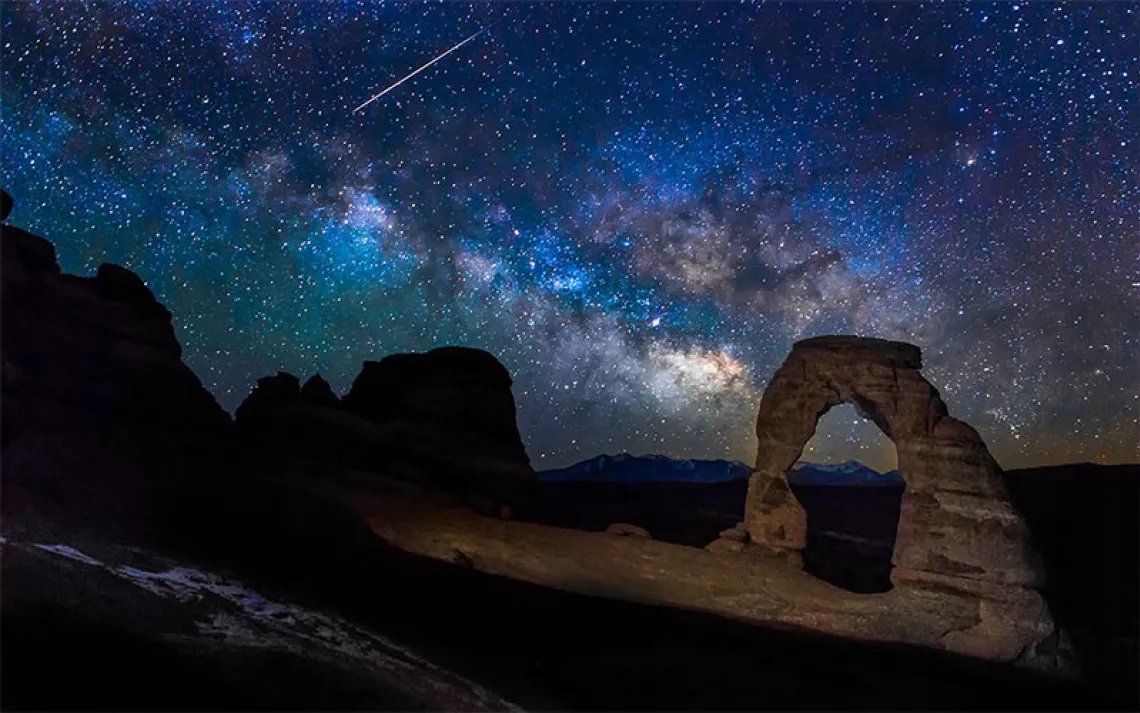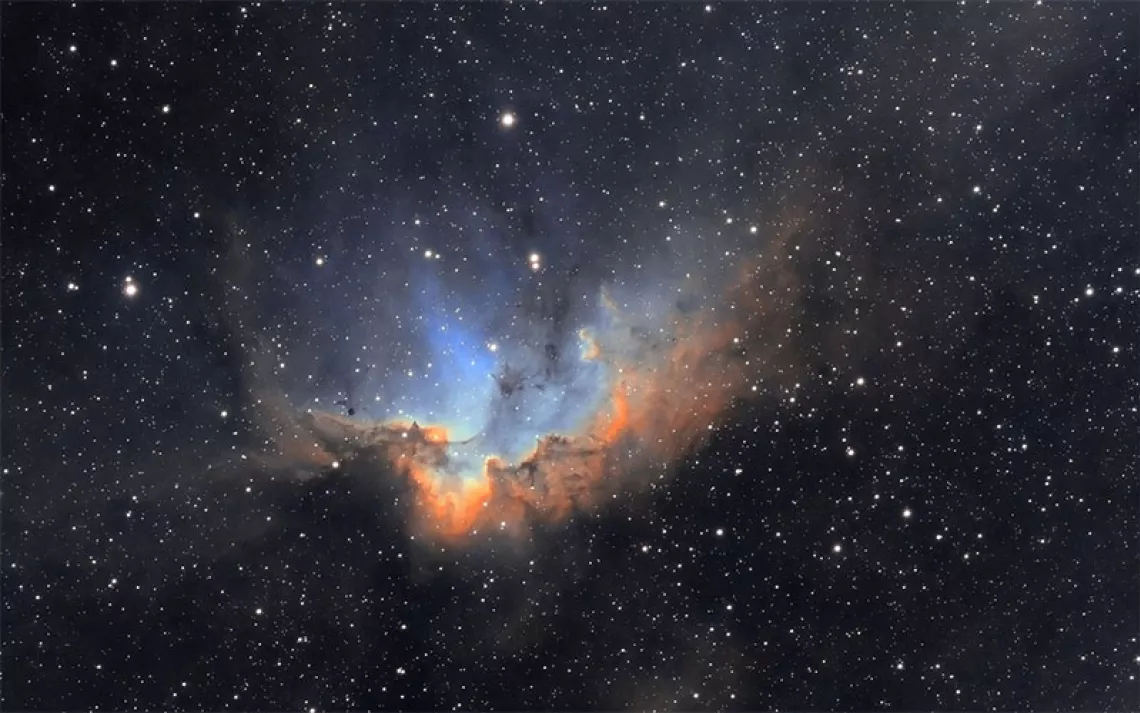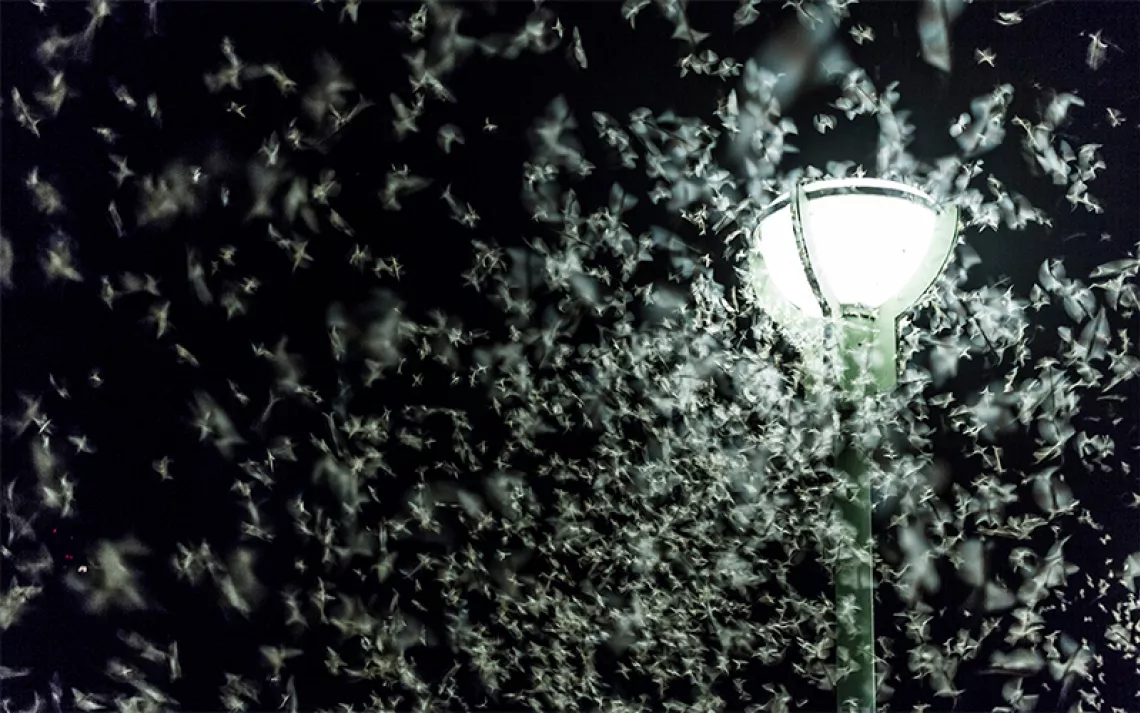On the Hunt for Stars: In Search of a Truly Dark Night Sky
A writer discovers finding an unblemished night sky is harder than she imagined

Ancient bristlecone forest | Photo by Harun Mehmedinovic
WHEN I WAS A KID, someone gave me a copy of Find the Constellations, the classic kids' stargazing book by H.A. Rey. I read it with great intensity but little understanding. The night sky seen from my Metro Detroit backyard looked nothing like the illustrations in the book. The only constellations I could spot consistently were the obvious ones: Orion and the Big Dipper.
My generation was the first in my family to live this way. When my mom was a child, her neighborhood was thick with stars. My grandparents had bought a house on the edge of Detroit so they could grow crops and still live close enough to the metropolis to work in the factories. When my mom walked through the fields on her way to school, pheasants would burst out of the grass in front of her. The city lights were still far enough away that the night sky was a star riot.
The house in which my mom grew up was one of two that the family lost to eminent domain as Metro Detroit's suburban ambitions spread outward in the 1960s. The house's remains were buried under a parking lot near I-75, something that my mom would comment on, casually, whenever we parked on top of it.
By the time I came around, the area was an Escher maze of malls, parking lots, and drive-through fast-food joints lit up bright enough to lure cars from the nearby freeway. Every few years, a pheasant would appear in our backyard looking confused. The stars were history.

Photo by Andreas Levers
During my lifetime, the world has gotten even brighter. The gas station down the street from my San Francisco apartment is lit up like an alien landing site at all hours. Affordable LED lights enabled my neighbors to install individual ones on every step leading up to their porch, as if hoping that Busby Berkeley would stop by and choreograph a dance number. Every night, the skyscrapers downtown light up like Christmas tree ornaments.
It seems like it's always been this way. It hasn't. Electricity's eclipse of the nightly firmament is a distinctly modern phenomenon. Being the first in my family to grow up without stars comes with a particular kind of territory: I'm the first to think that stars are anything special. The once-ordinary is now spectacular.
I came to this realization late. It didn't really strike me until last summer, when I, like millions of others, went on a quest to see some darkness: specifically, a few minutes when the moon would cover the sun during broad daylight.
To get to a place where I would be able to see Earth's personal star go dark, I traveled hundreds of miles. I crossed multiple state lines. I listened to "Total Eclipse of the Heart" many, many times. Finally, I was in Idaho.
When the eclipse came to pass and the sky darkened to a purplish black, the oohs and aahs of hundreds of people filled the air. The campers around us had been acting nonchalant, but now that we were all together in the dark, wonder was afoot. I took off my eclipse glasses and gazed at the burning ring in the sky. It looked like a tiny live-action heavy metal album cover. It was very cool.
But it made me wonder: What else were the stars and planets doing? Why had I applied this level of obsessive road-tripping to see the moon slide over the sun like a lid over a pot when I had never even tried to see what was actually going on up there on a clear, dark night? With a little planning, I could be seeing galaxies. So I began a second quest, one in search of a night sky like the one that my grandparents had grown up with.
It turned out to be much harder than I imagined.

Photo by Harun Mehmedinovic
THE FIRST PEOPLE WHO HAD ACCESS TO public lighting didn't seem to miss the night much. "Most of the crimes against person and property are committed at night in darkness," a reporter for the Pittsburgh Gazette Times wrote in 1911. "It is a wise local administrative policy that looks kindly upon liberal use of electric lamps for street lighting, particularly in those sections of a large city where crooks like to hide. A sufficiently lighted city is always attractive, well-advertised, and of course progressive."
Cities were so eager to be illuminated that they moved restlessly from one technology to another. Oil lamps were replaced by gaslights, which were replaced by structures called "moon towers," which cities ran on evenings when the moon wasn't full. The towers, which were lit by arcs of raw electricity, were built as high as possible, both because they were so bright and because shorter versions had a history of electrocuting people who used them to light cigars.
In the United States of the late 19th century, Detroit had the most comprehensive moon tower system—122 towers covering 21 square miles of downtown. They ultimately fell out of favor because the towers cast strange shadows and, with the advent of the skyscraper, they weren't tall enough to effectively light the streets. Detroit sold its moon towers to Austin, Texas, where they still stand (minus the original arc lighting), woven into a city that is now so illuminated that they are barely noticeable anymore.
The moon towers were replaced by lightbulbs. Of all the technologies that have left their stamp on America, the lightbulb has become synonymous with innovation itself—a cartoon shorthand for genius and insight. I grew up taking regular field trips to a replica of the Menlo Park, New Jersey, workshop where Thomas Edison had tinkered with the carbon-thread incandescent lamp. The replica was part of a village that Henry Ford, our homegrown automobile magnate, had built to serve as an artifact of preindustrial America. On these visits, we were shown how to make hand-dipped candles. "Imagine," the bonnet-clad docent said, "that this was your only source of light, and you had to make enough to last your parents for an entire month." No, I couldn't imagine it.
I also couldn't imagine a world where light was exciting. In her book about the history of artificial light, Brilliant, Jane Brox writes that as Edison's workshop began to have success with the lightbulb in 1879, wagons full of people—farmers, visitors from the city—began to show up at the laboratory to see the new lights. Once the visitors started showing up by the thousands, Edison stopped letting them inside the factory. They still came—they just stood out on the lawn instead.
Brox describes a funeral for a kerosene lamp held by the Adams Electric Cooperative, in Pennsylvania. "Buried here May 3, 1941," the eulogy read, "as a symbol of the drudgery and toil which its member families bore far longer than was necessary or right." Some farms, newly electrified, left their lights on all night in glee. Other farmers took their old oil lamps outside and smashed them.
People quickly habituated to each leap forward in lighting technology. During World War II, German bombers used London's lights as a navigational tool. In the city's first defensive blackout, Brox writes, Londoners found that they were so dependent on lighting that many couldn't find their own homes in the dark. Some people wandered into trees and canals.
When my grandparents were children, electricity was distant and urbane—it didn't work its way out to the countryside until the Roosevelt-era Rural Electrification Administration. My mother's parents met as teenagers on the migrant farmworker circuit, and their stories from that time were not about stars but about darkness. Darkness, in their telling, was not a good thing. In one story, they stopped by the side of the road to sleep on their way to the next job. It was a moonless night, and they kept stumbling over encampments made by other sleeping travelers.

Photo by Andreas Levers
If I ever went back to that roadside, I would probably find it lined with LED billboards. According to one scientific paper, the United States, on average, became 6 percent brighter each year between 1947 and 2000. To experience the kind of night sky my grandparents saw regularly, my best bet was to go to one of the national or state parks designated as an "International Dark Sky Park"—a certification developed by the International Dark-Sky Association, which was founded by two astronomers in the late 1980s. The idea behind the dark-sky parks is simple: The night sky is a natural resource that deserves preservation every bit as much as, say, watersheds or wildlife corridors. To be certified as a dark-sky park, a place needs to make basic infrastructure fixes, like shielding its lights so that they shine only on the ground, rather than into the atmosphere. A dark-sky park also needs to contribute to making its own little corner of the world a darker place by educating visitors about its nighttime modifications and monitoring, and by working with nearby municipalities and other potential allies on a night-friendly lighting code.
Figuring out which dark-sky park to visit was tricky. Joshua Tree has dark-sky status, but the western edge of the park glows with the night haze of Palm Springs and Los Angeles (though the eastern edge still manages to be one of the darkest places in California).
After much deliberation, I decided on the North Rim of the Grand Canyon. The national park's dark-sky status was still in the provisional stages (the park has until 2019 to retrofit all of its lighting fixtures), but if it failed to impress me with its darkness, I could always drive on to Bryce Canyon, which claimed to be one of the three darkest places in America accessible by paved road.
IT WAS A LONG DRIVE FROM San Francisco to northern Arizona, so I stopped in Las Vegas. The lights there were so bright and so insistent that they seemed almost like a natural phenomenon, and in one sense, they were. After Hoover Dam was finished in the 1930s, the then-tiny city had access to so much electricity that it cloaked itself in neon.
Wandering around Vegas on the way to a dark-sky park was the sensory equivalent of eating a tower of donuts the day before Lent. Downtown, much of Fremont Street was covered with a giant canopy—basically a fake sky—made of LED lights. The sky oscillated between images of prisms turning into birds, then flames, and casino advertisements. Nearby was a 12-story slot machine that sold $25 zip-line rides underneath the fake sky.
The next morning, on my way out of town, I stopped by the Neon Museum. The sun was so bright that the museum provided parasols for visitors. All around me, ancient signs leaned up against each other like companionable, sun-bleached giants: a single flamingo feather from the old Flamingo Hotel, a gold nugget glittering with incandescent bulbs. The museum has been taking junked neon signs, fixing them up, and reinstalling them in spots near downtown. When Las Vegas is unearthed by the archaeologists of the future, it will be fairly clear what we worshiped.

Devils Tower National Monument, Wyoming | Photo by Harun Mehmedinovic
When I arrived at the Grand Canyon later that day, it felt almost as busy as the Vegas Strip. But as the sun set, the trail cleared out until I was all by myself, walking a narrow footpath along the edge of the mile-deep gorge. After a while, I realized something weird: The sun had set, but it wasn't getting any darker. I looked up and immediately saw what was to blame—the moon. The freaking full moon.
In kids' picture books, the moon and the stars hang out in the same illustrations like perfect pals. In real life, this huge moon was a diva so bright that only the strongest, brightest stars could even try to make an appearance. In my attempt to spend more time with the night sky in all its splendor, I had revealed how little I knew about even the most basic celestial rhythms. The planets and stars and I have never been on very familiar terms.
"Maybe if I fall asleep, the stars will come out," I thought. "Is the moon really going to be such a big deal at 3 A.M.?"
The moon was a big deal at 3 A.M. It was so bright that it made the Grand Canyon look fake, like a diorama in a museum of natural history. At this point, there was nothing to do other than enjoy the experience of seeing an icon of the American landscape lit up like a parking lot.
As I wandered around outside my lodge, I looked for examples of the dark-sky-friendly lighting that I'd been reading so much about. All the outdoor lighting had a warm, yellowish glow and some kind of cover to keep the light focused on the paths around the lodge and the cabins. Many of the lights were designed to look old, but even the ones that weren't had a retro quality, because they were covered. In the past, lamps were covered because the light they generated was precious and expensive and we only wanted it to glow in one direction. Now we were using shaded lamps to preserve the darkness. The only bright spot in the whole human firmament was the dish room behind the kitchen and a Pepsi machine, which glowed near the visitor center like an artifact from outer space. The front of the machine was printed with a giant photo of the Grand Canyon, as though trying to disguise itself.
I looked at the few stars I could see and tried to feel grateful.
LOSING THE NIGHT SKY IS NOT just an issue of nostalgia or aesthetics. We, like most of the other creatures on this planet, evolved to use night and day as cues to regulate our physiology. The near-constant presence of artificial light affects humans and other species in unnerving ways.
Researchers have found that women who work the late shift have a higher-than-average risk of developing breast cancer. This may be because exposure to blue light (the spectrum often emitted by neon lights) can lead to decreased melatonin levels. Melatonin is a hormone that, among other things, helps suppress the body's nocturnal production of estrogen—and too much estrogen has been shown, in some studies, to increase the risk of cancer. A global study of cancer data from 158 countries found an elevated risk of lung, breast, colorectal, and prostate cancers in areas where artificial lighting is common, even after other environmental factors like air pollution were taken into account.
The effects on wildlife are even more clear. Artificial lighting has a documented history of messing with bird migration, baby-turtle survival, salmon spawning, and lightning-bug sex. This is largely because many species evolved to use the moon as part of their navigation system—not the moon plus a coastal hotel development.
Scientists learned about these effects on wildlife the hard way. In the mid-20th century, office buildings began leaving their lights on all night. New fluorescent lights brought dramatic reductions in lighting bills, and it was ridiculously pretty to see downtown skylines lit up so brightly. Then some cities, including Chicago, discovered that they had built their skyscrapers in the center of migratory-bird corridors. Many species of songbirds migrate at night and use the moon and the constellations as guides. The lit-up buildings disoriented the birds, causing them to either slam into the buildings or circle them until they dropped from exhaustion. During peak migration, workers would arrive to find the sidewalks littered with dead warblers and thrushes.

The Milky Way from Crater Lake National Park, Oregon | Photo by Harun Mehmedinovic
Getting precise numbers is difficult because many casualties are eaten by predators before anyone spots them, but an estimated 365 million to 988 million birds are killed by colliding with windows in the United States annually, and many of those collisions happen at night. Dave Willard, an ornithologist at the Field Museum of Natural History in Chicago who catalogs the migratory birds that are discovered dead on Chicago's streets, has found that a building that turns off its lights at night reduces its death toll by as much as 80 percent. One of the most notorious bird killers in the area, a convention center on the shores of Lake Michigan, saw yearly casualties drop from a high of 2,400 in the early 1990s to a sixth of that once it reduced the number of lights left on at night.
Successes like this happen, but so do new problems. Every September, New York City's Tribute in Light creates two four-mile-high pillars of light near the site of the old World Trade Center, in remembrance of the September 11 attacks. Migratory songbirds like American redstarts, blue warblers, and wood thrushes become trapped in the beams' glare. Today, volunteers from the National Audubon Society monitor the light towers to guard against bird deaths. Every time an exhausted bird plummets to the ground, or the count of circling birds reaches 1,000, the volunteers alert the September 11 Memorial, which shuts off the lights for 20 minutes to give the birds time to move on. In 2015, Tribute in Light had to be shut down eight times.
Around the world, cities are switching over to LED lights, which are vastly more energy efficient than the incandescent bulbs and sodium-vapor lights they replace. But while the LEDs are better from an energy and climate change perspective, they are very likely worse for wildlife and human health. LEDs typically emit a bluish tone (though there are ones that cast a more yellow light), and that makes them even more competitive with the moon, giving them the potential to kill even more wildlife than their predecessors. In the summer of 2016, the American Medical Association declared LED streetlights—which made up 10 percent of America's supply at the time—to be a public-health risk because of their potential effect on human circadian rhythms.
A FEW WEEKS AFTER MY POORLY TIMED TRIP to the Grand Canyon, I set out for another dark-sky park: Death Valley. I was headed for the Eureka Dunes, a place that I'd been to briefly, years ago, after one of the most harrowing, boulder-riddled drives of my life. But when I set up camp near the entrance of the park the evening of my arrival, I thought the sky looked strange. Hazy. Not like the desert skies that I remembered at all.
The next morning, a park ranger cleared up my confusion. "Yup, it's the wildfires," he said. Two weeks earlier, some of the worst wildfires in California history had broken out in Northern California. The smoke blanketed the Bay Area for a week before clearing. But some of the haze had moved southward on the winds.
"What about the Eureka Dunes?" I asked. "Those will be clear, right?" The ranger looked at me with gentle pity.
The only solution, other than to quit, was to try to get above the smoke. The highest campground in Death Valley is Thorndike, 7,400 feet above sea level and reached via a very bumpy dirt road. I decided to go for it. When I reached the rustic campsite set at the top of the road, I could see smoke lying over the valley like a pancake—a thick cloud made of the angry ghosts of burnt subdivisions.
The problem with Thorndike, though, was it was a whole season colder up there, and I hadn't come prepared. Neither, it turned out, had a lot of other people at the campground. On my way back from the bathroom before bed, I saw two men sitting in the cab of a truck with its engine running, eating ramen and looking miserable. I wasn't feeling much better, but I was determined to tough it out and had put on every single article of clothing I had packed, one on top of the other. It took what felt like forever to get warm enough to fall asleep. When the alarm went off at 3 A.M., I unzipped the tent window and looked out.
There was a galaxy out there. A huge galaxy. Our galaxy. There were stars beyond count, an infinity of worlds whose names I did not know.
I thought of that line from The Great Gatsby when Nick Carraway looks out across the water and goes on about how he almost imagines how interesting the world was when it was a wilder place, about what it must have been like for man to be "face to face for the last time in history with something commensurate to his capacity for wonder." Nick Carraway clearly needed to get out more.
I stood there, shivering, for hours, taking it all in.
This article appeared in the March/April 2018 edition with the headline "Dark Matters."
First recorded use of street lamps
Fourth-century-A.D., Antioch, in what was then Syria. "For here at least, sleep is no lord of mankind," wrote the Greek academic Libanius.
Distance from which the nighttime glow of Los Angeles is visible on a clear night
270 miles
Possible reduction in U.S. nighttime electricity use if dark-sky-friendly lighting were more broadly implemented
20 to 50%
Amount of money this would save per year
$10 billion
Number of metric tons of carbon dioxide emissions this would prevent
44 million
Annual increase in brightness of Earth's cities at night from 2012 to 2016
2.2%
Percentage increase in car collisions and crime after cities in England and Wales began dimming their streetlights to save money
0
Percentage of vertebrates threatened by outdoor lighting
30
Percentage of invertebrates threatened by outdoor lighting
60
Countries with the most pristine night skies
Chad, Central African Republic, Madagascar
Countries with the greatest levels of light pollution
Kuwait, Singapore, Qatar
Estimated number of birds killed on the night of August 22, 1887, after being trapped in the glow of the newly electrified torch held by the Statue of Liberty
1,500
Percentage of people in Europe and the U.S. who experience some form of light pollution
99
Percentage of North Americans who can't see the Milky Way from where they live
80
WHAT YOU CAN DO
Ask your city's mayor to join the effort to preserve a dark sky and reduce light pollution in your community: sc.org/night.
Join the Sierra Club's Grassroots Network team dedicated to night-sky conservation: sc.org/nightskyteam.
Take a Sierra Club trip to Death Valley or the Grand Canyon. Details at sc.org/adventure-travel.
MORE
Check out our guide to some of the darkest places in the United States and around the world: sc.org/darkskyguide.
 The Magazine of The Sierra Club
The Magazine of The Sierra Club



